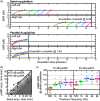The Parallel Auditory Brainstem Response
- PMID: 31516096
- PMCID: PMC6852359
- DOI: 10.1177/2331216519871395
The Parallel Auditory Brainstem Response
Abstract
The frequency-specific tone-evoked auditory brainstem response (ABR) is an indispensable tool in both the audiology clinic and research laboratory. Most frequently, the toneburst ABR is used to estimate hearing thresholds in infants, toddlers, and other patients for whom behavioral testing is not feasible. Therefore, results of the ABR exam form the basis for decisions regarding interventions and hearing habilitation with implications extending far into the child's future. Currently, responses are elicited by periodic sequences of toneburst stimuli presented serially to one ear at a time, which take a long time to measure multiple frequencies and intensities, and provide incomplete information if the infant wakes up early. Here, we describe a new method, the parallel ABR (pABR), which uses randomly timed toneburst stimuli to simultaneously acquire ABR waveforms to five frequencies in both ears. Here, we describe the pABR and quantify its effectiveness in addressing the greatest drawback of current methods: test duration. We show that in adults with normal hearing the pABR yields high-quality waveforms over a range of intensities, with similar morphology to the standard ABR in a fraction of the recording time. Furthermore, longer latencies and smaller amplitudes for low frequencies at a high intensity evoked by the pABR versus serial ABR suggest that responses may have better place specificity due to the masking provided by the other simultaneous toneburst sequences. Thus, the pABR has substantial potential for facilitating faster accumulation of more diagnostic information that is important for timely identification and treatment of hearing loss.
Keywords: assessment; auditory brainstem response; electroencephalography; evoked potentials; objective audiometry.
Figures











Similar articles
-
Optimizing Parameters for Using the Parallel Auditory Brainstem Response to Quickly Estimate Hearing Thresholds.Ear Hear. 2022 Mar/Apr;43(2):646-658. doi: 10.1097/AUD.0000000000001128. Ear Hear. 2022. PMID: 34593686 Free PMC article.
-
ABR thresholds to tonebursts gated with Blackman and linear windows in adults with high-frequency sensorineural hearing loss.Ear Hear. 2002 Aug;23(4):358-68. doi: 10.1097/00003446-200208000-00011. Ear Hear. 2002. PMID: 12195178
-
Evaluation of Speed and Accuracy of Next-Generation Auditory Steady State Response and Auditory Brainstem Response Audiometry in Children With Normal Hearing and Hearing Loss.Ear Hear. 2018 Nov/Dec;39(6):1207-1223. doi: 10.1097/AUD.0000000000000580. Ear Hear. 2018. PMID: 29624540 Free PMC article.
-
Unraveling the Mystery of Auditory Brainstem Response Corrections: The Need for Universal Standards.J Am Acad Audiol. 2017 Nov/Dec;28(10):950-960. doi: 10.3766/jaaa.16112. J Am Acad Audiol. 2017. PMID: 29130443 Review.
-
Clinicians' Guide to Obtaining a Valid Auditory Brainstem Response to Determine Hearing Status: Signal, Noise, and Cross-Checks.Am J Audiol. 2018 Mar 8;27(1):25-36. doi: 10.1044/2017_AJA-17-0074. Am J Audiol. 2018. PMID: 29392291 Review.
Cited by
-
Comparing methods for deriving the auditory brainstem response to continuous speech in human listeners.Imaging Neurosci (Camb). 2025 Jun 3;3:IMAG.a.19. doi: 10.1162/IMAG.a.19. eCollection 2025. Imaging Neurosci (Camb). 2025. PMID: 40800859 Free PMC article.
-
Neuroinflammation in a Mouse Model of Alzheimer's Disease versus Auditory Dysfunction: Machine Learning Interpretation and Analysis.Res Sq [Preprint]. 2023 Sep 27:rs.3.rs-3370200. doi: 10.21203/rs.3.rs-3370200/v1. Res Sq. 2023. PMID: 37841847 Free PMC article. Preprint.
-
Techniques for Obtaining High-quality Recordings in Electrocochleography.Front Syst Neurosci. 2020 Apr 15;14:18. doi: 10.3389/fnsys.2020.00018. eCollection 2020. Front Syst Neurosci. 2020. PMID: 32351368 Free PMC article.
-
Understanding Standard Procedure in Auditory Brainstem Response: Importance of Normative Data.J Audiol Otol. 2024 Oct;28(4):243-251. doi: 10.7874/jao.2024.00458. Epub 2024 Oct 10. J Audiol Otol. 2024. PMID: 39501685 Free PMC article.
-
Towards detection of brain injury using multimodal non-invasive neuromonitoring in adults undergoing extracorporeal membrane oxygenation.Biomed Opt Express. 2020 Oct 19;11(11):6551-6569. doi: 10.1364/BOE.401641. eCollection 2020 Nov 1. Biomed Opt Express. 2020. PMID: 33282508 Free PMC article.
References
-
- American Academy of Audiology. (2012). Audiologic guidelines for the assessment of hearing in infants and young children. Reston (VA, 2-52) Retrieved from https://www.asha.org/articlesummary.aspx?id=8589961387.
-
- BC Early Hearing Program. (2012). Audiology assessment protocol. Retrieved from http://www.phsa.ca/Documents/bcehpaudiologyassessmentprotocol.pdf.
-
- Brambrink A. M., Evers A. S., Avidan M. S., Farber N. B., Smith D. J., Martin L. D., Olney J. W. (2012) Ketamine-induced neuroapoptosis in the fetal and neonatal rhesus macaque brain. Anesthesiology: The Journal of the American Society of Anesthesiologists 116(2): 372–384. doi:10.1097/ALN.0b013e318242b2cd. - PMC - PubMed
-
- Burkard R. F., Don M., Eggermont J. J. (2006) Auditory evoked potentials: Basic principles and clinical application, 1st ed Philadelphia, PA: Lippincott Williams & Williams.
Publication types
MeSH terms
Grants and funding
LinkOut - more resources
Full Text Sources
Other Literature Sources

